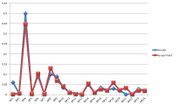Difference between revisions of "N-Glycan biosynthesis"
(Created page with "==Introduction== N-Linked glycans are attached in the endoplasmic reticulum to the nitrogen (N) in the side chain of asparagine in the sequon. The sequon is an Asn-X-Ser or A...") |
|||
| Line 1: | Line 1: | ||
| + | [[File:N-Glycan1.JPG|thumb|The first version of the model, made in the system BioUML]] | ||
| + | [[File:KOR 238.JPG|thumb|Model and experiment results for the patient KOR_238]] | ||
| + | [[File:Compartment1.jpg|thumb|Model of the first Golgi compartment]] | ||
| + | |||
==Introduction== | ==Introduction== | ||
| Line 5: | Line 9: | ||
N-linked glycans are extremely important in proper protein folding in eukaryotic cells, in cell-cell interactions and in personalized medicine<ref>[http://en.wikipedia.org/wiki/Glycan#N-Linked_glycans en.wikipedia.org/wiki/Glycan]</ref>. | N-linked glycans are extremely important in proper protein folding in eukaryotic cells, in cell-cell interactions and in personalized medicine<ref>[http://en.wikipedia.org/wiki/Glycan#N-Linked_glycans en.wikipedia.org/wiki/Glycan]</ref>. | ||
| − | ==Mathematical model | + | ==Mathematical model of N-Glycan biosynthesis== |
| + | |||
| + | === Model realization === | ||
| − | |||
| − | |||
| − | |||
Because of an important role of N-Glycans in personalized medicine it was decided to work out a mathematical model of its biosynthesis in BioUML. The research was begun with Reference pathway from KEGG database implementation <ref>[http://www.genome.jp/kegg-bin/show_pathway?scale=1.0&query=&map=map00510&scale=1.0&auto_image=&show_description=hide&multi_query= N-Glycan biosynthesis - Reference pathway]</ref>. | Because of an important role of N-Glycans in personalized medicine it was decided to work out a mathematical model of its biosynthesis in BioUML. The research was begun with Reference pathway from KEGG database implementation <ref>[http://www.genome.jp/kegg-bin/show_pathway?scale=1.0&query=&map=map00510&scale=1.0&auto_image=&show_description=hide&multi_query= N-Glycan biosynthesis - Reference pathway]</ref>. | ||
Reaction rate equations were generated by KEGGtranslator<ref>[http://www.cogsys.cs.uni-tuebingen.de/software/KEGGtranslator/ KEGGtranslator]</ref>, a number of necessary parameters, such as Michaelis-Menten constants, were taken from BRENDA Enzyme Database<ref>[http://www.brenda-enzymes.org/ BRENDA]</ref>. | Reaction rate equations were generated by KEGGtranslator<ref>[http://www.cogsys.cs.uni-tuebingen.de/software/KEGGtranslator/ KEGGtranslator]</ref>, a number of necessary parameters, such as Michaelis-Menten constants, were taken from BRENDA Enzyme Database<ref>[http://www.brenda-enzymes.org/ BRENDA]</ref>. | ||
| − | + | === Model optimization === | |
| − | + | The next step was the model reduction: the decrease in the number of model parameters and materials, which allowed to significantly simplify the model, speed up the [[Simulation]] and compare the model results with the experiment. | |
We use the expiremental data for Korcula population <ref>[http://www.ncbi.nlm.nih.gov/pubmed/21653738 High throughput isolation and glycosylation analysis of IgG-variability and heritability of the IgG glycome in three isolated human populations.]</ref> and made the [[Optimization]] of model parameters was performed for every individual patient. | We use the expiremental data for Korcula population <ref>[http://www.ncbi.nlm.nih.gov/pubmed/21653738 High throughput isolation and glycosylation analysis of IgG-variability and heritability of the IgG glycome in three isolated human populations.]</ref> and made the [[Optimization]] of model parameters was performed for every individual patient. | ||
| Line 22: | Line 25: | ||
To give more intuitive representation [[Glycan structures]] property was used and to achieve the optimum accuracy we supposed that the distribution of the N-glycans in each Golgi compartment is modeled as a well-mixed reactor<ref>[http://www.plosone.org/article/info%3Adoi%2F10.1371%2Fjournal.pone.0000713 Systems Analysis of N-Glycan Processing in Mammalian Cells]</ref>. | To give more intuitive representation [[Glycan structures]] property was used and to achieve the optimum accuracy we supposed that the distribution of the N-glycans in each Golgi compartment is modeled as a well-mixed reactor<ref>[http://www.plosone.org/article/info%3Adoi%2F10.1371%2Fjournal.pone.0000713 Systems Analysis of N-Glycan Processing in Mammalian Cells]</ref>. | ||
| − | |||
==References== | ==References== | ||
<References/> | <References/> | ||
Revision as of 14:33, 1 April 2014
Contents |
Introduction
N-Linked glycans are attached in the endoplasmic reticulum to the nitrogen (N) in the side chain of asparagine in the sequon. The sequon is an Asn-X-Ser or Asn-X-Thr sequence, where X is any amino acid except proline and the glycan may be composed of N-acetyl galactosamine, galactose, neuraminic acid, N-acetylglucosamine, fructose, mannose, fucose, and other monosaccharides.
N-linked glycans are extremely important in proper protein folding in eukaryotic cells, in cell-cell interactions and in personalized medicine[1].
Mathematical model of N-Glycan biosynthesis
Model realization
Because of an important role of N-Glycans in personalized medicine it was decided to work out a mathematical model of its biosynthesis in BioUML. The research was begun with Reference pathway from KEGG database implementation [2].
Reaction rate equations were generated by KEGGtranslator[3], a number of necessary parameters, such as Michaelis-Menten constants, were taken from BRENDA Enzyme Database[4].
Model optimization
The next step was the model reduction: the decrease in the number of model parameters and materials, which allowed to significantly simplify the model, speed up the Simulation and compare the model results with the experiment.
We use the expiremental data for Korcula population [5] and made the Optimization of model parameters was performed for every individual patient.
To give more intuitive representation Glycan structures property was used and to achieve the optimum accuracy we supposed that the distribution of the N-glycans in each Golgi compartment is modeled as a well-mixed reactor[6].
References
- ↑ en.wikipedia.org/wiki/Glycan
- ↑ N-Glycan biosynthesis - Reference pathway
- ↑ KEGGtranslator
- ↑ BRENDA
- ↑ High throughput isolation and glycosylation analysis of IgG-variability and heritability of the IgG glycome in three isolated human populations.
- ↑ Systems Analysis of N-Glycan Processing in Mammalian Cells


